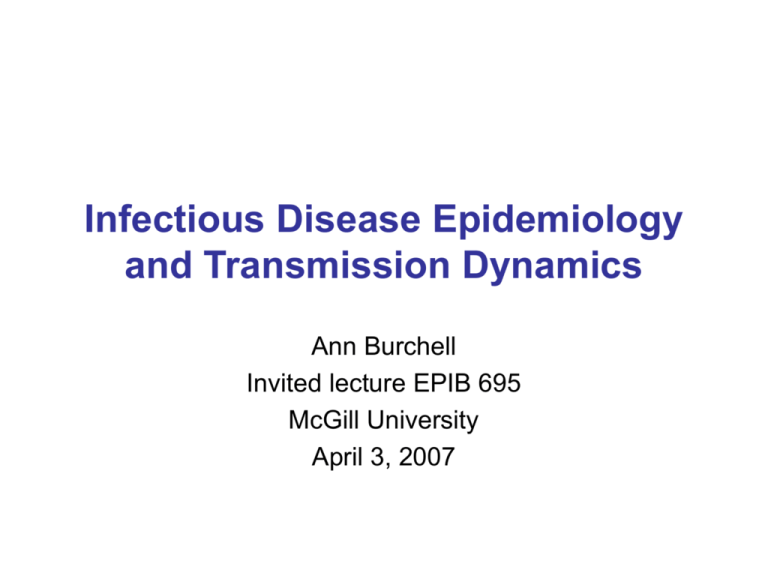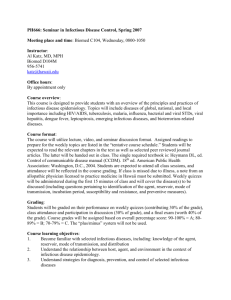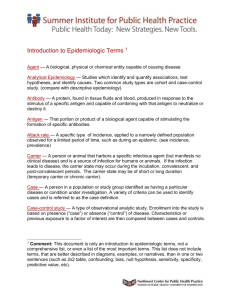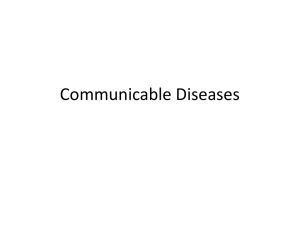Infectious Disease Epidemiology and Modeling
advertisement

Infectious Disease Epidemiology and Transmission Dynamics Ann Burchell Invited lecture EPIB 695 McGill University April 3, 2007 Objectives 1) To understand the major differences between infectious and noninfectious disease epidemiology 2) To learn about the nature of transmission dynamics and their relevance in infectious disease epidemiology 3) Using sexually transmitted infections as an example, to learn about the key parameters in transmission dynamics to appreciate the use of mathematical transmission models to assess the impact of prevention interventions (e.g., vaccines). Infectious disease epidemiology Definition of infectious disease (Last, 1995) “An illness due to a specific infectious agent or its toxic products that arises through transmission of that agent or its products from an infected person, animal, or reservoir to a suceptible host, either directly or indirectly through an intermediate plant or animal host, vector, or the inanimate environment” How is infectious disease (ID) epidemiology different from non-ID epidemiology? • Prevalence affects incidence, a case can be a risk factor – Prevalence not just a measure of burden of disease in a population, but also the probability of encountering an infected person – Means contact patterns between people are critical • People can be immune Some key terms to describe individuals • Susceptible: uninfected, but able to become infected if exposed • Infectious: infected and able to transmit the infection to other susceptible individuals • Immune: possessing cell-mediated or humoral antibody protection against an infection • Diseased/clinical infection: implies the presence of clinical signs of pathology (not synonymous with infected) • Latent infection / subclinical infection: implies presence of infectious agent but absence of clinical disease • Carrier: implies a protracted infected state with shedding of the infectious agent. Carriers may be diseased, recovering, or healthy. Key time periods for an infectious disease Giesecke, J. Modern Infectious Disease Epidemiology. 2002. Some key terms to describe the infectious disease at the population level • Epidemic: The occurrence in a community or region of cases of an illness clearly in excess of normal expectancy • Outbreak: An epidemic limited to localized increase in the incidence of a disease • Endemic: The constant presence of a disease or infectious agent within a given geographic area or population group • Pandemic: An epidemic occurring over a very wide area, crossing international boundaries and usually affecting a large number of people Last, JM. A Dictionary of Epidemiology. 1995. Examples of transmission routes Direct transmission Indirect transmission Mucous membrane to mucous membrane – sexually transmitted diseases Water-borne – hepatitis A Across placenta – toxoplasmosis “Proper” air-borne – chicken pox Transplants, including blood – hepatitis B Food-borne – salmonella Skin to skin – herpes type I Vectors – malaria Sneezes, coughs - influenza Objects/fomites – scarlet fever (e.g. toys in a day care centre) Giesecke J. Modern Infectious Disease Epidemiology. 2002. p. 16 Reproductive rate, R • Also called “reproductive number” • Average number of new infections caused by 1 infected individual • In an entirely susceptible population – Basic reproductive rate, R0 • In a population where <100% are susceptible – Effective reproductive rate, R = proportion susceptible x R0 Basic reproductive rate, R0 R0 > 1 Infection spreads (epidemic) R0 = 1 Infection remains constant (endemic) R0 < 1 Infection dies out Determinants of R0 For a pathogen with direct person-to-person transmission R0 = βcD where β is the probability of transmission per contact between infected and susceptible persons c is the contact rate D is the duration of infectivity Mathematical Model of Transmission Dynamics: Susceptible-Infectious-Recovered (SIR) model • Assumptions – – – – Population is fixed (no entries/births or departures/deaths) Latent period is zero Infectious period = disease duration After recovery, individuals are immune • People can be in one of three states – Susceptible to the infection (S) – Infected and infectious (I) – Recovered/immune (R*) * Not to be confused with R denoting reproductive number… unfortunate nomenclature! Giesecke J. Modern Infectious Disease Epidemiology. 2002. pp. 126-130 Rate of change Proportion in state at time t 1 OUT Susceptible dS/dt = - βcSI St = St-1 - βcSt-1It-1 (S) 1 1 IN Infected 2 OUT dI/dt = + βcSI – I/D It = It-1 + βcSt-1It-1 – It-1/D (I) 2 2 IN Recovered (R) dR/dt = + I/D Rt = Rt-1 + It-1/D Example SIR Model • Consider the following values – – – – N = 1000 people Transmission probability, β = 0.15 Contact rate, c = 12 contacts per week Infection duration, D = 1 week • Basic reproductive rate: R0 = 0.15 * 12 * 1 = 1.8 • Effective reproductive rate at time t: Rt = St * R0 Mathematical Models of Infectious Disease Transmission Dynamics • Frequently used in infectious disease epidemiology • Major goal is to “further understanding of the interplay between the variables that determine the course of infection within an individual, and the variables that control the pattern of infection within communities of people” Anderson RM & May RM. Infectious Diseases of Humans. Dynamics and Control. 1991. Why develop a model? • To understand the system of transmission of infections in a population • To help interpret observed epidemiological trends • To identify key determinants of epidemics • To guide the collection of data • To forecast the future direction of an epidemic • To evaluate the potential impact of an intervention Types of transmission models • Deterministic/compartmental – SIR model example – Categorize individuals into broad subgroups or “compartments” – Describe transitions between compartments by applying average transition rates – Aim to describe what happens “on average” in a population – Results imply epidemic will always take same course • Probabilistic/stochastic (Monte Carlo, Markov Chain) – Incorporates role of chance and variation in parameters – Provides range of possible outcomes – Particularly relevant for small populations and early in epidemic • Main challenge for both types of models? Good data for transmission parameters! Sources of data for model parameters: The example of sexually transmitted infections (STI) • Recall the three main parameters are: – Transmissibility (β) – Duration of infectivity (D) – Contact rate (c) • Where do estimates of these parameters come from? β Anderson RM. Transmission dynamics of sexually transmitted infections. In: Sexually Transmitted Diseases. Holmes KK et al., eds. 1999. pp. 25-37 Transmissibility (β): Measurement • Measured as the probability of transmission from an infected to a susceptible partner (attack rate) • Sources of data – Contact tracing – Discordant couples – Studies of sexually active individuals who report partners with known STI status, or if the prevalence of the STI in the pool of partners is well known • Challenges – Enrollment of sexual partners may be difficult – Identification of contacts between infected and susceptibles, and direction of transmission – What is a “contact”? Duration of infectivity (D): Measurement • Sources of data – Duration of clinical disease – Duration of infection • Challenges in measurement – – – – Duration of disease = duration of infectivity? Asymptomatic versus symptomatic Ethical obligation to treat identified infections May need to rely on historical data of questionable quality Contact rate (c) • Typically measured as the rate of new partner acquisition (e.g., per year) • Model so far assumes homogeneity in contact rate • Data source is sexual behaviour surveys – General population – Selected populations (e.g., adolescents, adults aged 18-45, students, gay and bisexual men, drug users) Number of partners in past 5 years. British National Survey of Sexual Attitudes and Lifestyles (NATSAL), 2000 Female Male 60 Percentage 50 40 30 20 10 0 0 1 2 Johnson AM et al. Lancet 2001; 358:1835-42. 3 to 4 5 to 9 10 or more Contact rate (c) • Clearly, the contact rate is heterogeneous • One cannot assume that all individuals have the same contact rate • For sexual behaviour, an important concept is the “core group” – A small group of individuals with a high contact rate that contribute disproportionately to the spread of STIs in the population – STI becomes concentrated in this core group Random mixing and the contact rate (c) • An assumption of the simple models seen so far is that mixing is random • Every individual has an equal chance of forming a partnership with every other individual • Survey data show that mixing is not random for many characteristics (e.g., age, ethnicity, religion, education), but tends to be assortative – “Like” mix with “like” • But is mixing assortative with respect to past sexual history (and by extension, the likelihood of STI infection)? Partner choice and sexual mixing Anderson RM. 1999. Contact rate (c): measurement challenges • Surveys of individuals obtain data on their sexual behaviour, but will be incomplete for their partners • Sexual network studies get detailed partner data, but are usually localized and may not be generalizable • General population surveys are more representative of majority, but may insufficiently capture members of the core group • Validity of self-reported sexual behaviour and social desirability bias β, c, and D estimates: Bottom line • Uncertainty and limitations in parameter estimates • Well-written papers will – Identify the source or reasoning behind parameter estimates – Conduct sensitivity analysis to determine how much the model results depend on parameter values • Sometimes the transmission model will identify a lack of knowledge in these parameters, and can direct empirical research to obtain more data Example of a mathematical transmission model to assess the impact of a prevention intervention Hughes JP, Garnett GP, Koutsky L. The theoretical population-level impact of a prophylactic human papillomavirus vaccine. Epidemiology 2002; 13:631-639 Human papillomavirus (HPV) • Over 40 types of HPV infect the epithelial lining of the anogenital tract • Some can lead to cancer of the cervix, and may also cause cancers of the vagina, penis, or anus (high-risk oncogenic types) • Some produce genital warts (low-risk types) Epidemiology of HPV • HPV present in 5%-40% of asymptomatic women of reproductive age • As many as 75% of adults are thought to be infected with at least one HPV type in their lifetime • For the vast majority, the infection causes no ill health effects and is cleared within 1-2 years • Among women in whom HPV infection persists, time from initial infection to cervical cancer thought to be 10-15 years Worldwide Distribution of Cervical Cancer, 2002 Canada '05 Morbidity 7.6 per 100,000 Mortality 2.0 per 100,000 Rate per 100,000 women Vaccine to prevent cancer! • Gardasil™ by Merck – Protects against infection with HPV-16 and HPV-18, as well as HPV-6 and HPV-11, the types that cause most genital warts – Vaccine efficacy 89%+ (Villa et al., 2005) – Approved for use in girls and women aged 9-26 in Canada • Cervarix™ by GlaxoSmithKline – Protects against infection with HPV-16 and HPV-18, the types that cause most cervical cancers – Division of Cancer Epidemiology, McGill University involved in design & data analysis of trial – Vaccine efficacy 83%+ (Harper, Franco et al., 2004) Hughes JP et a. The theoretical population-level impact of a prophylactic human papilloma virus vaccine. Epidemiology 2002; 13:631-9. • Model 1 is a compartmental model of HPV transmission dynamics • Sexually active population, which authors implicitly defined as having contact rate c > 0 (i.e., acquiring new partners over time) • Vaccine benefits: ↓ susceptibility, ↓ transmissibility, duration of infectiousness • Vaccine failure: take, degree, duration ↓ μ Sexually active population (η) Φ μ Vaccinated (v) 1-Φ μ σ Susceptible (x) φλ μ λ Infected (w) Infected (y) γ αγ Recovered, immune (z) μ Hughes JP et al. Epidemiology 2002; 13:631-9. μ β, D, and c parameter estimates • Transmissibility (β) – Female-to-male = 0.7 – Male-to-female = 0.8 • Duration of infectiousness (D) – 1.5 years • Contact rate (c) – High activity class: 3% of population, 9.0 new partners per year – Medium activity class: 15% of pop, 3.0 new partners per year – Low activity class: 82% of pop, 1.4 new partners per year – Mixing parameter, ε = 0.7, where ε = 1 is fully random, and ε = 0 is fully assortative Hughes JP et al. Epidemiology 2002; 13:631-9. % reduction --44% 68% 30% 19% 12% * 90% vaccine coverage, 75% vaccine efficacy, 10-year protection, similar natural history † 90% vaccine coverage in high and medium sexual activity class, 10% coverage in low sexual activity class Hughes JP et al. Epidemiology 2002; 13:631-9. Hughes JP et al. Epidemiology 2002; 13:631-9. Hughes et al - Conclusions • Given assumptions, an HPV vaccine for a given type would reduce prevalence of that type by – 44% if females and males vaccinated – 30% if only females vaccinated • Over a broad range of assumptions, female-only vaccination would be 60%-75% as effective as a strategy which vaccinated both females and males • Vaccination targetted to high-risk individuals only would reduce prevalence by no more than 19%, probably less given difficulty in reaching these individuals Hughes JP et al. Epidemiology 2002; 13:631-9.






